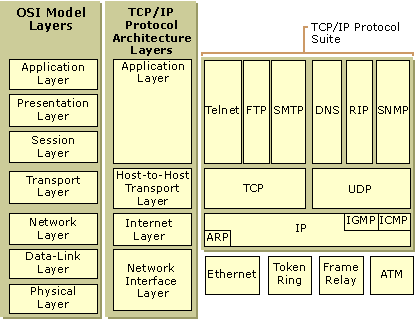
| # | Name | use | PDU | protocols | "address" | (connectivity) devices / HW | implemented by |
|---|---|---|---|---|---|---|---|
| 7 | Application | app's gateway to network. supports network apps. | "data"/"message" + header | HTTP FTP Telnet DHCP DNS SNMP SMTP BGP UPnP ... | host name | client/server peer-to-peer, "gateway" | app program in user mode |
| 6 | Presentation | "translation of syntax" from app to network e.g. compression, encryption, file formats, coding (MIME, ASCII / EBCDIC, XML, JSON | e.g. TLS/SSL | ||||
| 5 | Session | establishes, maintains, ends sessions. "dialog control" e.g. duplex; checkpointing / recovery | |||||
| 4 | Transport | reliable end-to-end data transfer: error detection / correction, acknowledgement, flow control, segmentation | TCP: segment UDP: datagram |
TCP (connecton-oriented: guaranteed delivery, incl. flow control, congestion control, segmentation), UDP (connectionless) | port | O.S. TCP/IP stack | |
| 3 | Network | routing datagrams from one host to another. hierarchical logical addressing, fragmenting, routing (path determination in internetwork), delivery error reporting. QoS prioritization. Best effort, connectionless. | datagram / packet | IP, ICMP, NDP, routing | IP address; protocol field | router | O.S. TCP/IP stack |
| 2 | Data link | move packet from one node to the next. framing, media access control, physical addressing, transmission error detection | frame | Ethernet (802.3), WiFi (802.11), ARP, PPP, Frame Relay, CDP, LLDP | MAC; Type field | NIC, switch, bridge, WAP | NIC firmware & driver |
| 1 | Physical | move bits from one node to the next. medium, encoding, signaling voltages, data rates, transceiving | (encoded / modulated bits) | hub, repeater, media converter, "modem" (ISDN, T1, POTS, DSL, 802.11 PHY), cabling / connectors / topology | NIC electronics / transceiver |
please do not throw sausage pizza away
layers 1 to 3: "lower" layers. network
layers 4 to 7: "upper" layers. host
"8th layer" problem: your users
TCP/IP model lumps application, presentation, session layers into an Application layer. Transport layer also called Host-to-Host layer. Network layer also called Internet(working) layer. TCP and IP work as a team, complementing each other. There is only one IP protocol and all Internet components that have a network layer component must run it. IP is the glue that binds the Internet together.
OSI layers and corresponding TCP/IP layers and protocols:


Encapsulation of PDUs:

